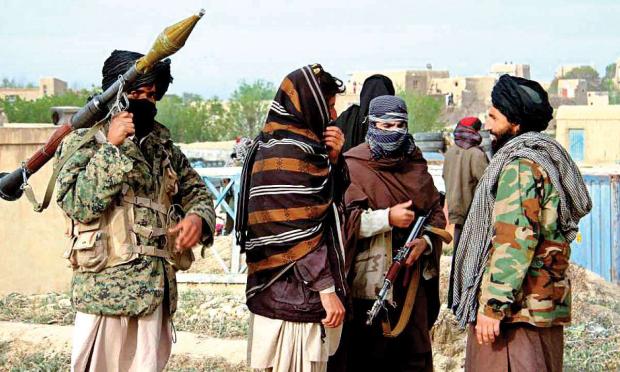Intelligence and international security agencies monitoring the Afghan situation are advising the United States that the Taliban is not in a position to sever ties with the al-Qaeda terror group because it is simply not possible. The two groups have fought together for several decades in Afghanistan sharing human and material resources and the links are intertwined.
Intelligence and international security agencies monitoring the Afghan situation are advising the United States that the Taliban is not in a position to sever ties with the al-Qaeda terror group because it is simply not possible. The two groups have fought together for several decades in Afghanistan sharing human and material resources and the links are intertwined. Untangling them is difficult is the bottom line. NBC News quoted Edmund Fitton-Brown, coordinator of the UN panel tracking the Taliban and terror groups inside Afghanistan as saying:
There is still clearly a close relationship between al-Qaeda and the Taliban. We believe that the top leadership of Al Qaeda is still under Taliban protection.” Al-Qaeda conducts training in Taliban-controlled areas, although there is no clear evidence of major recruitment or fundraising efforts, Fitton-Brown said, adding that "we understand that they do deploy alongside Taliban troops in certain theaters”. Not an iota of evidence exists that the relations between the Taliban and al-Qaeda have been severed after the Doha agreement on US troops withdrawal.
The Agreement asks the Taliban to distance itself from al-Qaeda, “prevent (it) from recruiting, training, and fundraising”, and that the Taliban “will not provide visas, passports, travel permits, or other legal documents to those who pose a threat to the security of the United States and its allies to enter Afghanistan”. In 2020, then Secretary of State issued a hasty statement saying the Taliban had “made a break” with terrorist groups. However, Al-Qaeda terrorists are still able to conduct training in Afghanistan. Its fighters are being deployed alongside Taliban forces.
The UN Security Council’s Analytical Support and Sanctions Monitoring Team’s latest report in 2021 says there is “little evidence of significant changes in relations between Al-Qaida and the Taliban”. The report is clear that “al-Qaeda assesses that its future in Afghanistan depends upon its close ties to the Taliban”. It puts the “overall number of members of al-Qaeda and its affiliates in Afghanistan at between 200 and 500, spread across at least 11 Afghan provinces”. The monitoring team says the fact that several al-Qaeda commanders have been killed in anti-terror operations in Taliban-controlled territory “underscores how close the two groups are”.
The Office of the Inspector-General of the US Department of Defense in its February, 2021, went further to say the two groups are intertwined in Afghanistan: “… it was unclear whether the Taliban was in compliance with the agreement, as members of al-Qaeda were integrated into the Taliban's leadership and command structure.” For the record, the Taliban says they are committed to the Doha Agreement and deny there are any “foreign” fighters or al-Qaeda members in Afghanistan. Neither the US, the UN or Nato believe them.
Taliban leaders have been quoted by a section of the American media as saying that terrorists from countries like Turkmenistan, Uzbekistan, China, Iran, Iraq, Turkey, Saudi Arabia and the United Arab Emirates did exist in Afghanistan, but that they are either no longer in the country or they can no longer operate separately. The intelligence reports the US receives suggest that the al-Qaeda is entirely dependent on the Taliban for survival. Being a smaller group with much less resources than the Taliban, and under direct pressure from the US and its allies, it needs the Taliban protection to operate inside Afghanistan. So long as the al-Qaeda actions are not traceable to the Taliban, the latter may not be inclined to confront the terror group.
Another issue is that the relations with al-Qaeda are dictated by the field commanders of the Taliban who have been interacting with the former on a daily basis in hostile areas for decades. The Pakistan-based political leadership of the Taliban, on the other hand, is not in a position to question or oppose the commanders. This partly explains why the Taliban leadership seems reluctant to de-link itself from al-Qaeda and confront it. Familial links between the two groups is another factor that needs consideration. Over the decades, al-Qaeda terrorists have been reported to have married girls from the Pashtun tribes in Taliban-controlled regions of Afghanistan.
Tribal customs and familial ties are difficult to sever, forged as they are with a sense of loyalty, intelligence sources admit. Nearly three decades of such relations have meant that there is a second generation of people who are the progeny of these marriages that has grown up and has taken up arms and joined the two groups as fighters.
Both believe in a fundamentalist form of Islam and as their relationship grew, also shared a regressive tribal code of the Afghan region they inhabited. It is this similarity that brought them together initially. In the initial years, al-Qaeda leaders like Osama bin Laden did not hesitate to accept the Taliban’s Mulla Omar as the influencer. In return, the terror group was allowed to operate freely in the country. Their relations survived several political and ideological upheavals, but survived nearly two decades of intense military pressure from the Americans.
With the arrival in 2014 of a common rival in the form of the Islamic State, both the Taliban and al-Qaeda became closer. It is believed the top leaders of the al-Qaeda and the Taliban have met several times in 2020 to decide on operational protocols to be observed after the American troops withdraw. The Taliban officially denies the meetings ever happened.
Referring to the present ties between the two, Saurav Sarkar, with the New Delhi-based Centre for Air Power Studies, wrote in a paper that currently the Taliban “have an available fighting force of 55,000-85,000 fighters and contests 50-60 percent of Afghan territory with 21 districts under full Taliban control, so an additional 400-600 al-Qaeda members will not make a significant difference”. Sarkar even speculates that in case the Taliban confronts the al-Qaeda it is possible that other regional groups might want to come out of the Taliban influence and “align themselves with the Taliban’s rivals such as ISKP and rebel Taliban factions like the Hizb-e-Vilayat-e-Islami”
There is still clearly a close relationship between al-Qaeda and the Taliban. We believe that the top leadership of Al Qaeda is still under Taliban protection.” Al-Qaeda conducts training in Taliban-controlled areas, although there is no clear evidence of major recruitment or fundraising efforts, Fitton-Brown said, adding that "we understand that they do deploy alongside Taliban troops in certain theaters”. Not an iota of evidence exists that the relations between the Taliban and al-Qaeda have been severed after the Doha agreement on US troops withdrawal.
The Agreement asks the Taliban to distance itself from al-Qaeda, “prevent (it) from recruiting, training, and fundraising”, and that the Taliban “will not provide visas, passports, travel permits, or other legal documents to those who pose a threat to the security of the United States and its allies to enter Afghanistan”. In 2020, then Secretary of State issued a hasty statement saying the Taliban had “made a break” with terrorist groups. However, Al-Qaeda terrorists are still able to conduct training in Afghanistan. Its fighters are being deployed alongside Taliban forces.
The UN Security Council’s Analytical Support and Sanctions Monitoring Team’s latest report in 2021 says there is “little evidence of significant changes in relations between Al-Qaida and the Taliban”. The report is clear that “al-Qaeda assesses that its future in Afghanistan depends upon its close ties to the Taliban”. It puts the “overall number of members of al-Qaeda and its affiliates in Afghanistan at between 200 and 500, spread across at least 11 Afghan provinces”. The monitoring team says the fact that several al-Qaeda commanders have been killed in anti-terror operations in Taliban-controlled territory “underscores how close the two groups are”.
The Office of the Inspector-General of the US Department of Defense in its February, 2021, went further to say the two groups are intertwined in Afghanistan: “… it was unclear whether the Taliban was in compliance with the agreement, as members of al-Qaeda were integrated into the Taliban's leadership and command structure.” For the record, the Taliban says they are committed to the Doha Agreement and deny there are any “foreign” fighters or al-Qaeda members in Afghanistan. Neither the US, the UN or Nato believe them.
Taliban leaders have been quoted by a section of the American media as saying that terrorists from countries like Turkmenistan, Uzbekistan, China, Iran, Iraq, Turkey, Saudi Arabia and the United Arab Emirates did exist in Afghanistan, but that they are either no longer in the country or they can no longer operate separately. The intelligence reports the US receives suggest that the al-Qaeda is entirely dependent on the Taliban for survival. Being a smaller group with much less resources than the Taliban, and under direct pressure from the US and its allies, it needs the Taliban protection to operate inside Afghanistan. So long as the al-Qaeda actions are not traceable to the Taliban, the latter may not be inclined to confront the terror group.
Another issue is that the relations with al-Qaeda are dictated by the field commanders of the Taliban who have been interacting with the former on a daily basis in hostile areas for decades. The Pakistan-based political leadership of the Taliban, on the other hand, is not in a position to question or oppose the commanders. This partly explains why the Taliban leadership seems reluctant to de-link itself from al-Qaeda and confront it. Familial links between the two groups is another factor that needs consideration. Over the decades, al-Qaeda terrorists have been reported to have married girls from the Pashtun tribes in Taliban-controlled regions of Afghanistan.
Tribal customs and familial ties are difficult to sever, forged as they are with a sense of loyalty, intelligence sources admit. Nearly three decades of such relations have meant that there is a second generation of people who are the progeny of these marriages that has grown up and has taken up arms and joined the two groups as fighters.
Both believe in a fundamentalist form of Islam and as their relationship grew, also shared a regressive tribal code of the Afghan region they inhabited. It is this similarity that brought them together initially. In the initial years, al-Qaeda leaders like Osama bin Laden did not hesitate to accept the Taliban’s Mulla Omar as the influencer. In return, the terror group was allowed to operate freely in the country. Their relations survived several political and ideological upheavals, but survived nearly two decades of intense military pressure from the Americans.
With the arrival in 2014 of a common rival in the form of the Islamic State, both the Taliban and al-Qaeda became closer. It is believed the top leaders of the al-Qaeda and the Taliban have met several times in 2020 to decide on operational protocols to be observed after the American troops withdraw. The Taliban officially denies the meetings ever happened.
Referring to the present ties between the two, Saurav Sarkar, with the New Delhi-based Centre for Air Power Studies, wrote in a paper that currently the Taliban “have an available fighting force of 55,000-85,000 fighters and contests 50-60 percent of Afghan territory with 21 districts under full Taliban control, so an additional 400-600 al-Qaeda members will not make a significant difference”. Sarkar even speculates that in case the Taliban confronts the al-Qaeda it is possible that other regional groups might want to come out of the Taliban influence and “align themselves with the Taliban’s rivals such as ISKP and rebel Taliban factions like the Hizb-e-Vilayat-e-Islami”.















